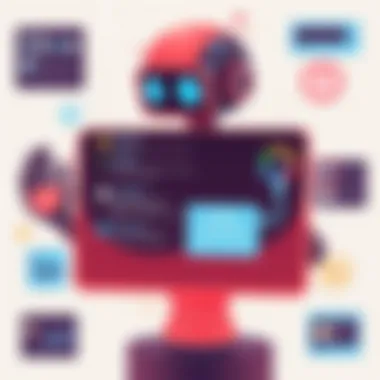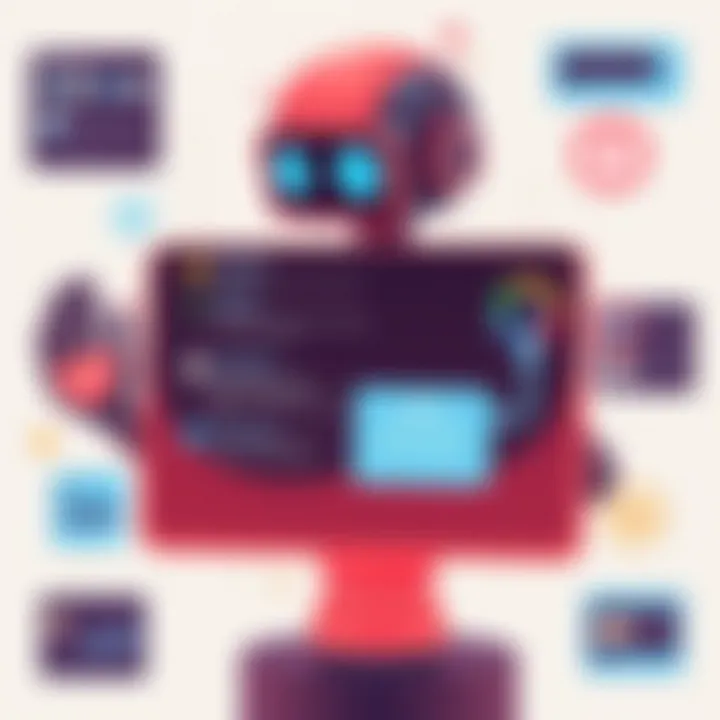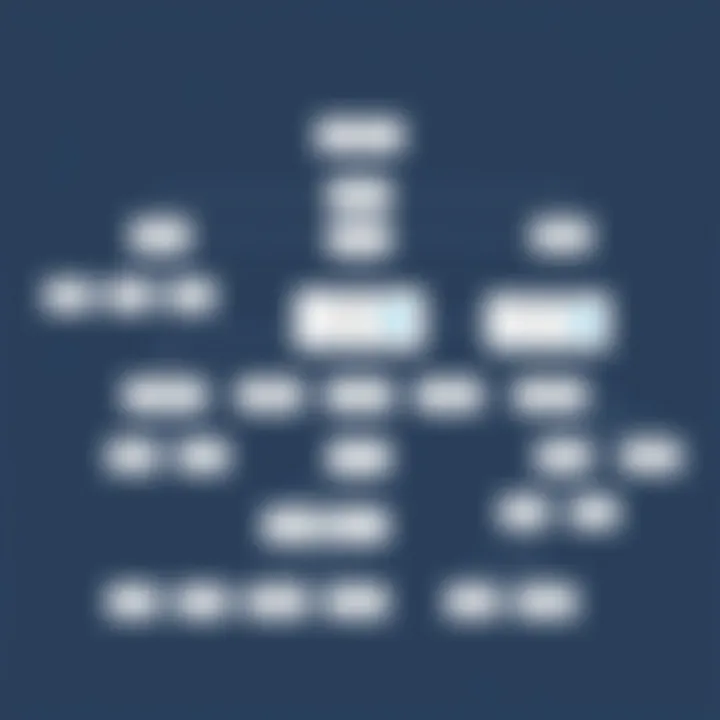Creating a JavaScript Bot: A Detailed Guide


Intro
Creating a bot in JavaScript isn’t just a passing fancy; it's become a significant aspect of the tech landscape. In recent years, bots have transformed how businesses operate, automate tasks, and interact with users. This guide aims to take you through the essentials of bot development, whether you're a greenhorn coder or have a few projects up your sleeve. Here, we’ll peel back the layers of bot creation, focusing on practical steps, the crucial tools you’ll need, and examples that will anchor your understanding.
As we delve deeper, you'll find that JavaScript stands out as a versatile language ripe for bot development. It's characterized by its unique blend of simplicity and robust functionality. It has emerged as a go-to choice for developers seeking to craft bots ranging from simple data-fetchers to complex interactive companions. The journey starts with understanding the very essence of what a bot is and how it can serve various applications from customer service to personal assistants. Let's roll up our sleeves and dig into this comprehensive exploration together.
Intro to Bot Development
Creating bots has become a staple in the tech industry, reflecting a growing demand for automating tasks and enhancing user experiences. In this section, we will explore the importance of understanding bot development and its multifaceted nature. As we plunge into this topic, we uncover how bots can simplify complex workflows, ultimately leading to increased productivity.
Bots are essentially software applications designed to perform specific functions autonomously. This begs the question: why is it vital to delve into bot development? First and foremost, bots can optimize repetitive tasks that would otherwise consume valuable resources. Think about customer service; instead of a human attending every call or email, a chatbot can handle multiple inquiries, freeing up personnel for more nuanced tasks.
Furthermore, with the right tools and frameworks, creating a bot has become accessible to both seasoned developers and new entrants. Understanding the foundational concepts of bot development equips you with the knowledge to create tailored solutions, whether you're looking to automate a mundane task or develop a sophisticated digital assistant.
As we dissect the various types of bots in the upcoming sections, you'll see how each serves a distinct purpose yet shares common threads. The goal here is to highlight their contributions while showcasing the uniqueness of their applications in daily life.
Understanding Bots
The definition of a bot is quite straightforward: it is a program designed to execute a specific task. However, diving deeper reveals a world where bots can operate in diverse environments, each with their respective functionalities. From automated tasks in social media to those scraping data from the web, the landscape is vast. Thus, understanding what constitutes a bot—and the mechanics behind them—provides a solid foundation for further exploration.
Types of Bots
When we categorize bots, we can primarily outline three types: chatbots, web scrapers, and task automation bots. Each type serves its unique purpose while playing a role in the overarching theme of automating repetitive or time-consuming tasks.
Chatbots
Chatbots are perhaps the most recognized form of bots in today’s digital landscape. They operate mainly in communication, serving as the bridge between users and services. Whether on websites or messaging platforms, chatbots assist by responding to queries in real-time. This immediate response capability helps enhance customer satisfaction, as individuals no longer need to wait for assistance.
A key characteristic of chatbots is their ability to simulate conversation and take actions based on user inputs. This makes them popular for various applications, such as customer support, online ordering, or even just entertaining users with small talk.
However, it’s worth noting the limitations of chatbots. Often, these bots rely heavily on pre-programmed responses and may struggle with complex queries or ambiguous questions. Despite this, their benefits in saving time and resources for businesses make them a valued choice.
Web Scrapers
Web scrapers focus primarily on gathering information from the internet. They automate the tedious process of data collection, enabling users to extract large sets of information without manual intervention. For research, price comparison, or market analysis, web scrapers play an integral role in ensuring decision-makers have access to current data.
The main feature of web scrapers is their ability to crawl various web pages and sift through data with remarkable speed and precision. This capability can produce vast amounts of information at a fraction of the time a human would require.
Yet, web scraping raises ethical concerns and challenges related to site terms of service and data privacy. Hence, while they provide immense advantages, developers need to tread carefully to avoid potential legal pitfalls associated with scraping practices.
Task Automation Bots
Task automation bots serve to streamline workflows by handling repetitive tasks that would otherwise require human intervention. Their design is to boost efficiency, reduce errors, and save time across various sectors.
These bots can automate tasks like data entry, social media posting, or even routine IT functions, making them essential for many businesses. Their ability to connect with APIs and other software means they can perform complex tasks that extend beyond simple automation.
However, the reliance on automation can lead to vulnerabilities if bots are not regularly maintained or updated. When bugs arise, or when the bot encounters unexpected input, the ramifications can affect entire operations. Thus, understanding proper implementation and monitoring is crucial.
In summary, the landscape of bot development encompasses various types and functionalities, each with its own advantages and challenges. As we navigate through the details of creating your own bot in JavaScript, appreciating these distinctions will set a solid groundwork for practical application.
Setting Up Your Environment
Establishing a robust environment is the backbone of any effective bot development process. As the saying goes, you can't build a house without a solid foundation, and the same principle holds true in programming. When embarking on a journey to create a bot using JavaScript, setting up your environment correctly directly impacts the efficiency, reliability, and scalability of the final product.
A properly configured environment allows developers to streamline workflows, troubleshoot issues smartly, and implement features with ease. In this section, we’ll look closely at the tools and configurations essential for creating a bot that not only works but thrives.
Choosing the Right Tools
Code Editor
A quality code editor can make all the difference in a developer's experience. Think of it as the workshop where all the magic happens. While there are numerous editors to choose from, Visual Studio Code stands tall as a favorite in the developer community. Its lightweight functionality and extensibility make it suitable for several programming tasks. The editor supports syntax highlighting, IntelliSense, and integrated terminal features.
One key characteristic of Visual Studio Code is its vast ecosystem of extensions. These can facilitate everything from debugging to version control, making the development process significantly smoother. However, users may find themselves overwhelmed by choices if they overindulge in extensions, resulting in a sluggish experience.
Node.js
Node.js serves as the runtime environment for JavaScript, transcending the browser and venturing into server-side scripting. The primary appeal of Node.js is its asynchronous, single-threaded architecture. This allows for numerous simultaneous connections with minimal overhead, which is particularly beneficial when building bots that require handling multiple user requests.
By leveraging Node.js, developers can use JavaScript both on the client and server side. One unique feature of Node.js is its npm (Node Package Manager) integration. With npm, developers can install libraries and frameworks that expedite bot development. However, beginners might experience a learning curve in understanding how to manage dependencies effectively.
Package Manager
A package manager simplifies the process of managing libraries and modules in a JavaScript project. Npm, the default package manager for Node.js, facilitates the installation, updating, and removal of these dependencies with just a few commands.
One key benefit of using a package manager like npm is its ability to ensure consistency in project dependencies across different environments. This is vital for collaborative projects where various developers work on the same codebase. However, relying too heavily on external libraries can lead to compatibility issues, if not managed appropriately.
Installing Node.js
Once you've selected your tools, the next step is the installation of Node.js. The installation process is straightforward; you can download the package from the official Node.js website. Make sure to choose the version that fits your operating system, whether it’s macOS, Windows, or Linux. During installation, you'll have the option to include additional tools which could assist in your development journey.
Configuring Your Project
With Node.js installed, configuring your project correctly sets the stage for a smooth development experience. Start by creating a directory for your bot project and navigating to it via your command line interface. From there, initialize your project using . This command will guide you through creating a package.json file which defines the metadata necessary for your project.
It's advisable to set your project up with essential dependencies as you go along. Use npm to install libraries needed for your bot, such as Axios or Cheerio, right from the beginning. This integration allows for easier management of application dependencies as your project evolves.
By investing time in setting up your environment correctly, you’ll lay a solid groundwork for successful bot development. Not only will this contribute to the efficacy of your work, but it will also enhance the overall learning experience. As you proceed, remember: having the right tools doesn’t guarantee success, but it certainly increases the odds.
Core JavaScript Concepts for Bots


Creating a bot using JavaScript hinges upon a solid understanding of key programming concepts. Mastering these concepts not only enhances your developing skills but also equips you to build effective, high-performance bots. This section will discuss asynchronous programming, working with APIs, and data structures, which form the backbone of modern JavaScript bot development.
Asynchronous Programming
Asynchronous programming is like trying to multitask in a fast-paced office. You don’t want to be stuck waiting for one task to finish before you start another. In the context of bot development, asynchronous operations help to manage tasks without blocking the main execution thread.
Promises
Promises are a way to handle asynchronous operations in JavaScript. A promise can be in one of three states: pending, fulfilled, or rejected. The real beauty of promises lies in their ability to chain actions together using and . This characteristic makes them particularly beneficial when working with data in a bot.
- Key Feature: The promise object represents the eventual completion (or failure) of an asynchronous operation.
- Why it's Popular: Many developers prefer promises because they result in cleaner and more readable code compared to traditional callback functions.
- Advantages/Disadvantages: A unique feature is that promises can be combined to execute multiple operations concurrently. However, they can also introduce complexity if not handled properly, especially in error management.
Async/Await
Async/await is syntactic sugar built on top of promises, simplifying asynchronous code even further. Using async functions helps developers write code that looks synchronous. This characteristic allows developers to write cleaner, more understandable code while still handling complex asynchronous tasks.
- Key Principle: The keyword allows a function to return a promise, while halts the execution of the function until the promise is resolved.
- Why it's Beneficial: Developers find async/await particularly useful because it avoids the so-called “pyramid of doom” often encountered with nested callbacks.
- Advantages/Disadvantages: Its unique feature is that it keeps the code structure linear, making it easier to follow for those new to asynchronous JavaScript. Yet, it can lead to unforeseen blocking scenarios if not used prudently throughout your bot’s implementation.
Working with APIs
Given that bots often need to fetch data from external sources, proficiency in handling APIs is crucial. APIs allow bots to interact with other software applications, ensuring they can pull in fresh data or push updates as needed. Familiarity with RESTful services and understanding JSON formats will undoubtedly set a strong foundation for bot development.
Data Structures
Understanding various data structures is essential for efficiently handling information. It’s like having the right tools in your toolbox. Two primary structures you'll rely on are arrays and objects.
Arrays
Arrays provide a way to store lists of items, making them ideal for scenarios where you need to manage collections of data, such as user messages or bot commands.
- Key Feature: Arrays are ordered and zero-indexed collections that can hold any type of data.
- Why it's Popular: Their built-in methods like , , and make manipulation straightforward and fun.
- Advantages/Disadvantages: While arrays are great for maintaining order, if you need to frequently access elements by a key, they may not be the best option.
Objects
Objects are collections of key-value pairs that pack data in a more structured way than arrays. They serve as the definitive way to handle user information or store properties of a bot.
- Key Feature: Objects allow for the association of various data types under a single key, ensuring a coherent structure.
- Why it's Popular: With ease of access via keys, objects are often used to represent real-world entities in a bot, allowing for clear organization.
- Advantages/Disadvantages: Their flexibility is a double-edged sword—while convenient for organizing data, excessive nesting can lead to complicated access paths.
Ultimately, a sound grasp of asynchronous programming, APIs, and data structures will prepare you for the journey ahead in bot development. Each of these core JavaScript concepts is pivotal to creating bots that are not just functional but also efficient and adaptable.
Using Libraries and Frameworks
In the realm of JavaScript development for bots, leveraging libraries and frameworks can be a game changer. They provide pre-built functions and utilities that save time and enhance productivity. The landscape of bot creation can be complicated, with varying requirements for tasks ranging from fetching data to parsing HTML. With the right libraries and frameworks, developers can streamline processes and minimize the potential for errors.
Choosing to utilize these tools not only simplifies coding but also enhances the efficiency of the bot’s performance. By integrating popular libraries and frameworks, developers can tap into a wealth of community support and resources, ensuring that they remain up-to-date with the latest advancements. This section delves into key libraries and frameworks that are essential for building effective bots in JavaScript.
Essential JavaScript Libraries
A robust toolbox is central to every developer’s success. Here’s a look at some of the essential JavaScript libraries that are pivotal for bot creation.
Axios
Axios serves as a promise-based HTTP client, making it easier to interact with APIs. Its primary contribution lies in how it greatly simplifies the process of making requests to external services. In the context of a bot, Axios shines particularly bright due to its ability to handle response data effectively, whether it's JSON or another format.
Key Characteristic: One of the standout features of Axios is its interceptors, which allow developers to modify requests or responses globally. This is particularly beneficial for implementing standardized error handling across your bot.
Unique Feature: Axios automatically transforms JSON data for you, which means less boilerplate code and reduced complexity in handling server responses.
Advantages: The rich feature set, ease of use, and strong community support makes Axios a top pick for many developers navigating the often choppy waters of API interaction. However, some might find that its size can be a downside for lightweight applications.
Node-fetch
Node-fetch is another powerful library designed to bring the API from the browser to Node.js. This library is particularly useful when you’re looking for a simple way to make HTTP requests in a Node environment.
Key Characteristic: Its straightforward and minimalistic approach allows developers to make requests without unnecessary complexity. This simplicity can be attractive to those who appreciate clean code.
Unique Feature: Node-fetch supports streaming responses, giving it an edge when dealing with large payloads without exhausting memory.
Advantages: It’s lightweight and has no dependencies, but users should note that it lacks some of the advanced features offered by Axios, such as interceptors.
Cheerio
When it comes to parsing and manipulating HTML, Cheerio has established itself as the go-to library. It's fast, flexible, and simple to use, resembling jQuery’s API.
Key Characteristic: Cheerio mainly facilitates server-side manipulation of HTML documents, making it ideal for web scraping tasks that many bots perform.
Unique Feature: Unlike other libraries, Cheerio allows for a lightweight approach, so you can select and modify elements without loading the full DOM, saving resources in the process.
Advantages: It’s an excellent choice for those needing a bare-bones solution for HTML parsing—perfect for developers who want high efficiency without the excess baggage.
Framework Overview
Frameworks provide a structural foundation, making the process of building bots even more intuitive. They often incorporate best practices in their design, contributing to more maintainable and scalable solutions.
Botpress
Botpress is a widely-recognized framework that empowers developers to create intelligent bots with agility. It’s designed to cater to a broad audience, from novices to seasoned programmers.
Key Characteristic: The user-friendly interface and visual flow editor simplify the bot development process significantly, which is crucial for developers who are just starting.


Unique Feature: Botpress enables developers to incorporate natural language understanding capabilities seamlessly, which contributes greatly to user experience.
Advantages: With its solid community backing, Botpress provides ample resources for troubleshooting and enhancement. However, new users might feel overwhelmed by its comprehensive capabilities.
Telegraf
Telegraf is tailor-made for building bots specifically for Telegram. Its simplicity and performance make it a solid choice for developers aiming to engage Telegram users.
Key Characteristic: Known for its easy setup and extensive middleware support, Telegraf allows developers to enhance their bots with custom functionalities.
Unique Feature: The framework supports inline queries, enabling users to interact seamlessly within conversations, an essential feature for engaging user interfaces.
Advantages: While Telegraf offers robust features, one downside is that it’s narrowly focused, meaning developers who wish to create bots for multiple platforms will need to look elsewhere.
Discord.js
Discord.js is a library specifically designed for interacting with the Discord API, allowing developers to create versatile bots across Discord’s platform.
Key Characteristic: Its event-driven architecture makes it particularly effective for handling incoming messages and server events, which is an integral aspect of Discord bot functionality.
Unique Feature: It supports rich content formats, such as embeds and reactions, allowing for more engaging interactions within Discord channels.
Advantages: The community support is strong, providing numerous resources for beginners. However, its complexity might pose some challenges for those who are inexperienced with event-driven programming.
Understanding how to leverage these libraries and frameworks can accelerate your bot development journey significantly. They each bring unique strengths to the table and can be selected based on your specific project needs.
Building Your First Bot
Building your first bot is a monumental step in your journey as a developer. This section aims to equip you with the foundational knowledge and practical skills necessary to create a functional bot tailored to your specific needs. Understanding the principles behind bot development not only broadens your technological toolkit but also enhances your ability to solve real-world problems through automation and interaction. What makes this endeavor especially valuable is the versatility of bots; their applications range from managing various online tasks to engaging users in meaningful interactions.
Defining Bot Purpose
User Interaction
User interaction is a cornerstone of many successful bots. This aspect emphasizes creating a two-way engagement channel between the user and the bot, transforming how information is exchanged. In today’s fast-paced digital world, users prioritize convenience and immediate feedback, and a bot designed for interaction meets these demands effectively. The key characteristic here is responsiveness. A bot that responds accurately to user inputs fosters a sense of reliability and trust.
Furthermore, an interactive bot can learn from past interactions, allowing it to tailor future responses and thereby enhancing the user experience. While there are many great features to consider, one must comprehend its potential drawbacks, like misinterpretation of commands or even user frustration from unexpected responses. However, with careful iteration and user feedback, these issues can be addressed. The bottom line is that user interaction is indispensable for creating bots that are not only functional but also engaging.
Task Automation
Task automation represents another essential dimension in bot development. It allows repetitive tasks to be executed swiftly without human intervention, saving time and minimizing errors. The crux of this approach lies in efficiency; by automating mundane processes, developers can focus their efforts on more complex issues requiring human insight. Task automation stands as a highly beneficial choice for this article because it is practical and applicable across a diverse array of scenarios, from data entry to web scraping.
Unique to task automation is its ability to integrate with various APIs, enabling bots to fetch and process data in real-time. One disadvantage, however, is the potential for misconfiguration, which can lead to unintended results and system strains. Despite such concerns, the advantages far outweigh the disadvantages in many situations, especially when focusing on enhancing productivity.
Coding the Basic Structure
Setting up the basic structure for your bot is akin to laying the foundation for a house— without a solid base, everything else risks falling apart. Start by establishing the core functionalities your bot will have. This includes defining key functions and organizing your code clearly. Use modules to break down tasks; for example, separate user interaction from data processing. This modular approach makes your code cleaner and easier to debug.
Implementing Functionality
Responding to Commands
Responding to commands is a pivotal facet for any bot intent on assisting users or executing tasks. The essence of effective command response lies in understanding user intent. To achieve this, you can first map out a list of possible commands that users might input. Implementing a natural language processing library can significantly enhance your bot's ability to discern commands accurately. One unique feature here is command recognition, which can evolve as the bot interacts more with its users.
However, a key consideration is the learning curve for both the bot and the user. The bot must be programmed to handle various phrasings gracefully without leading to frustration. This characteristic ensures that users find it intuitive and user-friendly.
Handling Inputs
Handling inputs revolves around correctly interpreting and processing user data. It plays a significant role in determining how well your bot performs. The main aim here is to ensure that any input provided is validated and processed efficiently to provide the expected output. A bot's ability to handle inputs correctly contributes significantly to its overall usability. A defining feature is the capacity to recognize and respond to invalid inputs without crashing or providing irrelevant information.
On the flip side, improper input handling can result in a poor user experience, leading users to abandon the bot altogether. Hence, building robust validation mechanisms and fail-safes is crucial. Overall, implementing thoughtful input handling can render your bot more resilient and user-friendly.
Testing and Debugging Your Bot
Testing and debugging are crucial steps in the bot creation process. They ensure that the bot behaves as expected, performs well, and handles user input correctly. If you skip this part, you risk delivering a malfunctioning bot to users, which can lead to frustration and ultimately, loss of trust in your capabilities. Skipping this could lead to issues like unexpected crashes or incorrect responses when users interact with your bot. A solid testing and debugging strategy not only helps resolve existing issues but also prevents them from cropping up in the future.
Importance of Testing
Testing is fundamental in bot development for various reasons. One key aspect is that it allows you to find and fix bugs before they become a bigger headache. When you test your bot, you can catch problems early, saving time and resources in the long run. Furthermore, thorough testing enhances the bot’s usability and reliability, which improves user experience.
Moreover, if your bot is deployed in a production environment, and it encounters a problem, the repercussions can be significant. This is where the value of testing shines— you can ensure high standards and reliability.
Common Testing Methods
There are several testing methods one can employ to ensure functionality. The two key methods are Unit Testing and Integration Testing.
Unit Testing
Unit testing focuses on validating individual components of your bot. It aims to ensure that each function performs as expected in isolation. The beauty of unit testing lies in its ability to systematically identify bugs at an early stage, thus addressing one piece of code at a time. It's a popular choice because it allows developers to make changes and add features while having the peace of mind that previous functionality remains intact.
Another unique feature of unit testing is its speed and ease. Tests can be run frequently, and when a new feature is added, developers can be confident that existing functionalities still work. However, unit testing does have its downsides; it doesn’t check how different components work together, which is where integration testing comes into play.
Integration Testing
Integration testing, on the other hand, evaluates how various modules or services work together. It's essential for catching bugs that emerge when two or more components interact. This method becomes increasingly relevant as the bot grows in complexity.
Integration testing is beneficial because it uncovers interface errors, ensuring that components integrate smoothly. A unique aspect of this type of testing is its ability to mimic real-world scenarios, thus providing more realistic performance insights. However, these tests can be more time-consuming compared to unit tests, and they may require stable environments to yield accurate results.
Debugging Techniques


Debugging techniques play a significant role in solving the errors found during testing. There are several approaches one can take.
- Console Logging: Implementing various statements at crucial points in your code can help you trace the flow and see content in real time. This often serves as a first line of action when facing issues.
- Breakpoints: If you are using Visual Studio Code or similar IDEs, setting breakpoints allows you to pause execution at critical points. This way, you can inspect values and program behavior step by step.
- Stack Traces: When errors occur, analyzing stack traces can provide insights into the function calls that led to the failure, pinpointing the exact line of code that needs attention.
Equipped with these techniques, developers can tackle bugs efficiently and improve the overall performance of their bots. By prioritizing testing and debugging, you ensure a robust and user-friendly bot experience.
Deploying Your Bot
Deploying your bot is a crucial step in the overall process of bot development. After spending countless hours coding and refining your bot, the time comes to get it out into the wild. This phase not only makes your bot accessible to users but also ensures that it can operate reliably in a real-world environment.
When thinking about deployment, several elements come into play. First and foremost, selecting a suitable hosting platform is critical. Each platform has its own strengths and weaknesses, and understanding these can save you time and headaches down the road. Moreover, considering scalability is key. If your bot gains traction, can your chosen platform handle increased traffic?
There are several hosting options like Heroku, AWS, and DigitalOcean. Each brings something unique to the table. Besides simply hosting your bot, factors such as pricing models, ease of use, and built-in features will help shape your decision.
Choosing a Hosting Platform
Heroku
Heroku stands out for its ease of deployment and user-friendly interface. This platform is extremely popular among developers, especially those new to the hosting game. A unique feature of Heroku is its git integration, which means you can deploy your bot with just a simple push command from your terminal. This seamless process can make getting your bot up and running feel almost effortless.
On the downside, Heroku's free tier comes with limitations, like sleeping apps and restricted usage hours. If your bot sees any significant user interaction, these restrictions may hinder performance, so it's something to consider.
AWS
When it comes to power and flexibility, Amazon Web Services (AWS) takes the cake. Known for its wide array of features, it can cater to almost any need your bot may have. The platform provides services like EC2 for instances and Lambda for serverless architecture. AWS is the go-to option if you're aiming to scale aggressively.
However, with its complexity comes a learning curve. Navigating AWS effectively requires some experience, and its pricing model can be confusing for newcomers. It might end up being more than you bargained for if you’re just looking to test the waters.
DigitalOcean
DigitalOcean is a favorite among developers for its straightforward pricing and simplicity. With easy-to-use droplets, deploying your bot on DigitalOcean doesn't require extensive knowledge about server management. Setup is quick, and the whole platform is designed with developers in mind.
A standout feature is the one-click application deployment, allowing a developer to get their bot up with minimal fuss. However, its support might lack the depth and coverage compared to AWS, so if issues arise, you might feel a bit on your own.
Deployment Process
Once you've chosen a hosting platform, the deployment process typically involves several steps. These include:
- Preparing the Application: Ensure your code is clean and all environment variables are set appropriately.
- Setting Up the Server: Configure the settings based on the chosen platform, focusing on aspects like the operating system and dependencies.
- Pushing Your Code: Use git or the platform-specific deployment method to get your code onto the server.
- Testing: Before announcing to the world, do a series of tests to ensure everything functions as expected.
- Managing Your Bot Post-Deployment: Monitor performance and user feedback to continue improving.
"Deployment isn't the end; it's the beginning of a new chapter for your bot’s journey."
This narrative of deploying your bot illustrates just how vital it is to make informed decisions that can affect the bot's initial reception and overall lifespan. By understanding these platforms and their features, you can align them with your needs and set your bot up for success.
Maintaining and Updating Your Bot
Creating a bot is just the beginning; maintaining and updating it is where much of the long-term value lies. In the fast-paced world of technology, a bot's relevance can rapidly dissipate if it isn’t kept in tune with the evolving needs of users and the environment in which it operates. Engaging the audience doesn’t stop post-deployment; it’s a continuous dance. This section delves into the importance of maintaining and updating your bot, highlighting how these practices can enhance its functionality and user satisfaction.
A bot that runs smoothly with the latest features is not only a badge of honor for its creator, but it's also a testament to understanding user needs and embracing feedback. Also, keeping dependencies up to date is crucial; outdated libraries can pose security risks or operational hiccups. Here are some key benefits of regular maintenance:
- User Retention: Users expect an evolving experience, and regular updates help keep them engaged.
- Bug Fixes: As with any software, issues will emerge. Regular maintenance allows you to catch and fix bugs before they become major headaches.
- Feature Expansion: Users might have new requests or ideas. By introducing features through updates, your bot can adapt to changing demands.
- Performance Enhancements: Staying on top of updates can optimize performance, making the bot faster and more resource-efficient.
"It's not about how you start; it's about how you finish and keep going."
Gathering User Feedback
Feedback from users serves as a compass guiding future updates and maintenance efforts. It is not enough just to deploy and forget your bot; interaction data, suggestions, and complaints are gold mines for improvement. This feedback loop not only fosters a sense of community but also helps identify areas that need your attention.
You can employ various methods to gather user feedback effectively:
- Surveys and Polls: After an interaction, sending a brief survey can pinpoint users' satisfaction levels and collect suggestions.
- Direct Communication: Providing channels for users to voice their thoughts can lead to actionable insights. A simple contact link or chat option can work wonders.
- Usage Analytics: Tracking how users interact with your bot reveals patterns of engagement. For instance, if certain features are ignored, think about whether they need more visibility or are irrelevant altogether.
By regularly assessing user input, you can prioritize which updates or changes will most positively impact user experience. Essentially, foster a culture where user feedback is valued; it often yields the best insights.
Implementing Updates
Once you have gathered and analyzed user feedback, the next step is implementing updates. This phase ties in directly with responsiveness and adaptability. An effective update strategy ensures that changes occur smoothly without disrupting the bot's core functionalities.
Here are some steps to consider when implementing updates:
- Prioritize Updates: Not all suggestions hold equal weight. Identify which updates yield the highest return on user satisfaction and impact on performance.
- Test Before Deployment: Before rolling out updates, conduct thorough tests in a controlled environment. This step prevents unforeseen bugs from reaching live users.
- Communicate Changes: When you've got an update ready, inform your users. Transparency fosters trust and keeps them engaged with new features.
- Monitor Post-Update Performance: After deployment, closely monitor the bot’s performance to ensure that the update hasn't inadvertently created any new issues.
Implementing a structured approach to updates is fundamental in ensuring longevity and user trust in your bot. The goal is not to merely respond to issues but to anticipate needs and actively improve the experience. Whether it's tweaking conversational flows or patching security concerns, updates are the lifeblood of user satisfaction.
Ending
Reflecting back on the intricate journey we've navigated through bot development, it’s clear that the task of creating a bot in JavaScript demands both a methodical approach and a willingness to learn. Nurturing an understanding of the fundamental programming concepts, as well as the tools that play a pivotal role in constructing such digital entities, can yield significant benefits. Developers, whether newcomers eager to dip their toes or seasoned veterans, find this realm ripe with opportunities for creativity and efficiency in task handling.
Reflecting on the Learning Journey
As we wrap things up, it’s essential to think about the skills and knowledge amassed throughout this guide. From setting up the environment to mastering APIs and libraries, each step builds toward creating something functional and effective. Consider that learning a new language or framework is similar to picking up a musical instrument. It requires consistent practice and a bit of patience. Many developers may have fumbled through initial attempts, experiencing frustrations along the way. However, such challenges are simply stepping stones that enrich one's skills.
Automation and interaction bots aren't just technical feats; they can streamline processes, enhance user engagement, and support efficient workflows. With every attempt, you sharpen your intellect, gaining confidence as you delve into the depths of bot programming.
"The journey of a thousand miles begins with a single step."
Ultimately, recognizing how far you've come by learning core bot functionalities inspires future exploration. Embrace the knowledge you’ve gained and keep that curiosity burning; in the tech world, staying static is rarely an option.
Encouragement for Future Development
The horizon of bot development is ever expanding. As technology evolves, the complexity of tasks that bots can handle multiplies. Fostering a passion for learning is vital in this landscape. Don't shy away from diving into new frameworks or experimenting with advanced techniques. Aim to engage with communities on platforms like Reddit or GitHub to share your insights and gather feedback.
Consider the rise of AI and machine learning — these domains hold tremendous potential for bot enhancements. You could integrate natural language processing into your chatbot to make conversations feel more human-like. Explore tools such as TensorFlow.js or use APIs that can augment your bot’s capabilities.
In closing, the world of JavaScript bot development holds a wealth of creativity and utility. Each project enriches your portfolio and enhances your problem-solving skills, leading you down an exciting path of discovery. Set your sights high, and use the foundation laid here as a springboard for future ventures.



